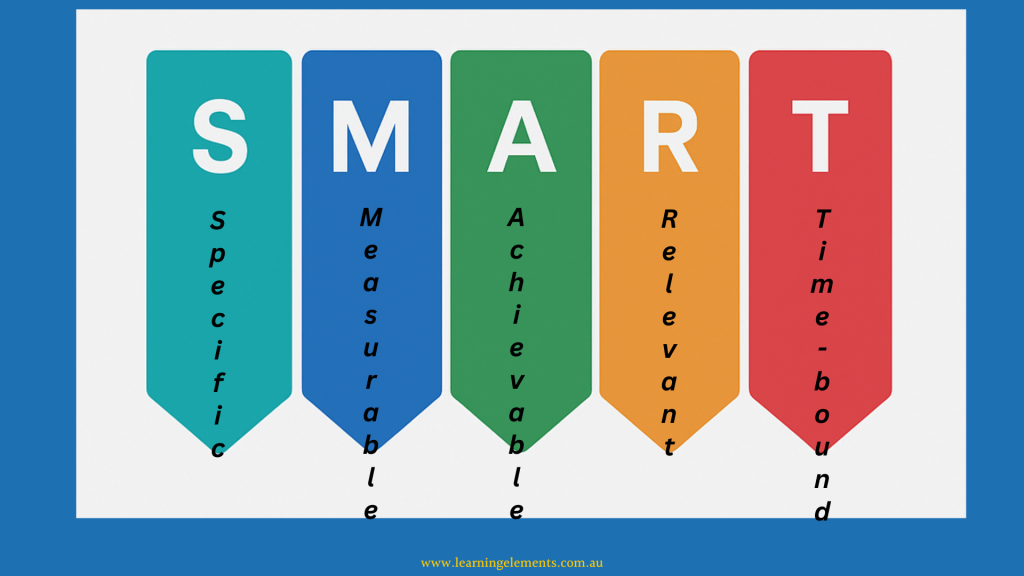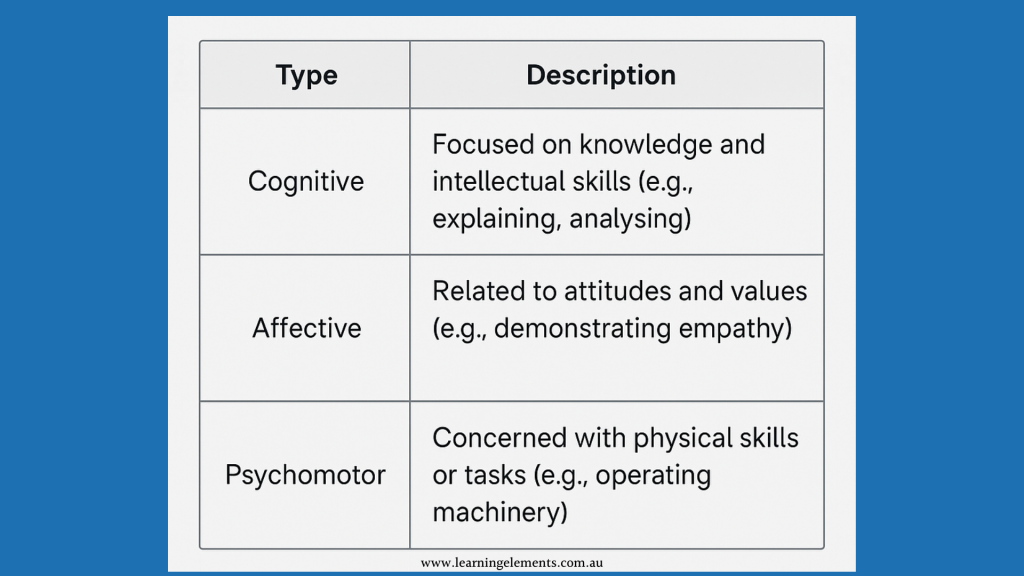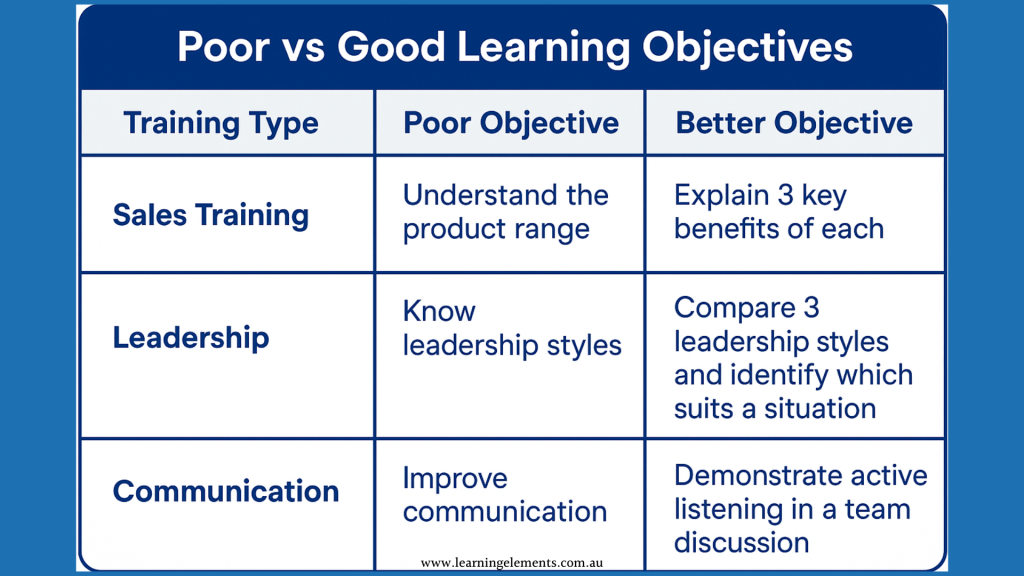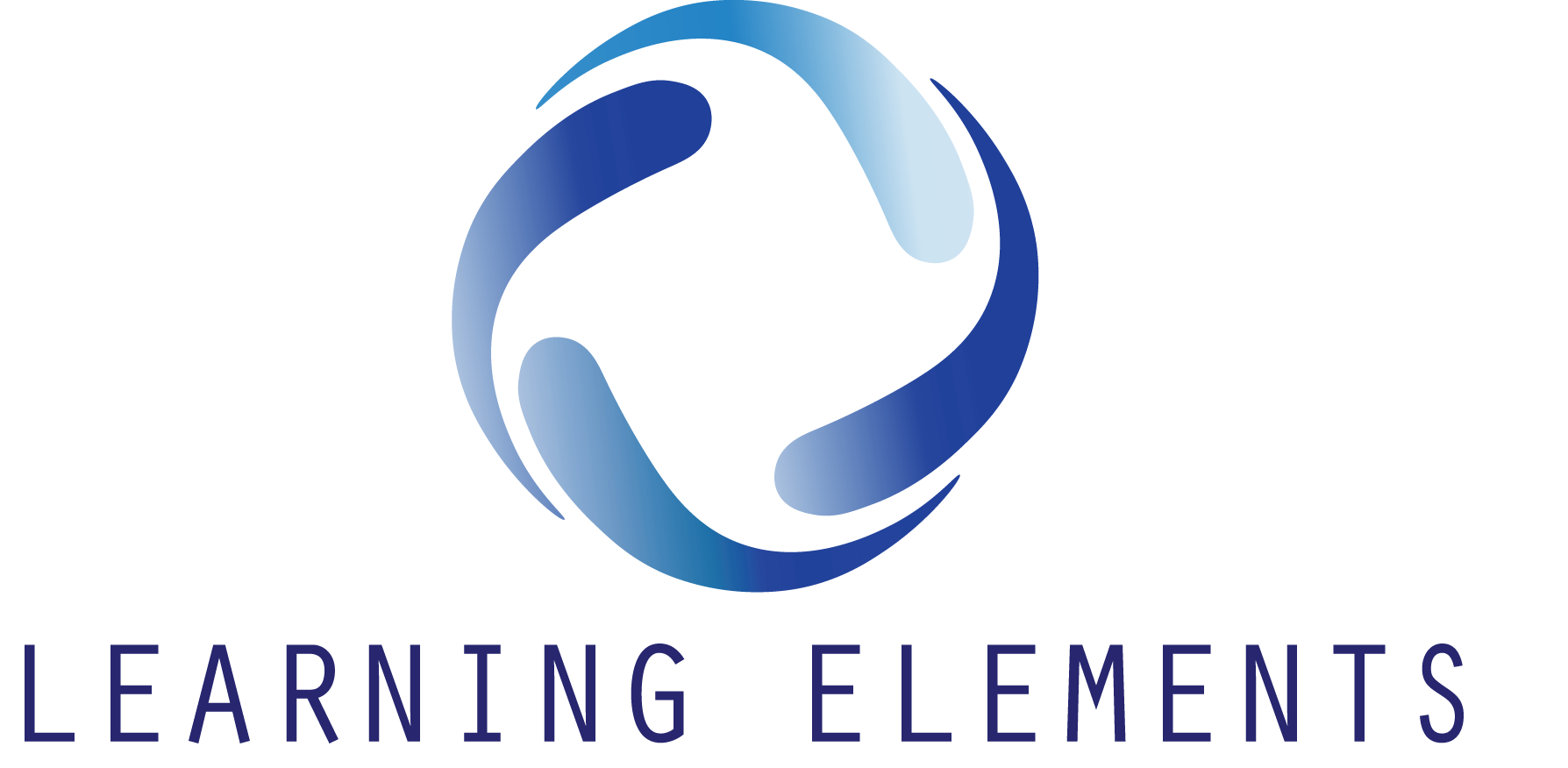What Are Learning Objectives? A Guide for Effective Training
Learning objectives are essential in instructional design and corporate training. In this guide, we’ll explore what learning objectives are, why they matter, and how to write them effectively for impactful training sessions.
What Are Learning Objectives?
Learning objectives are clear, specific statements that define what a learner is expected to know or be able to do by the end of a training session or course. They’re used in both corporate and academic training and help ensure the training is focused, measurable, and aligned with business goals.
Why Are Learning Objectives Important?
- They give clarity to both trainers and learners
- Help measure learning success effectively
- Ensure alignment between business goals and training content
- Make it easier to evaluate training effectiveness

Key Characteristics of Good Learning Objectives
- Specific: Avoid vague goals. Be clear about what’s expected.
- Measurable: Include outcomes you can observe or assess.
- Achievable: Ensure the goal can be completed within the training time.
- Relevant: Must connect to the job role or task.
- Time-bound: Define when the objective should be achieved.
How to Write SMART Goals for Training
This framework ensures that each objective is not only clear but also actionable and assessable.
For example: “By the end of the session, customer service reps will resolve at least three common complaints using the company’s resolution script.”
Looking to design training that delivers measurable results? Start by mastering how to write powerful learning objectives.
Steps to Formulate Clear Learning Objectives
- Start with a Needs Analysis
- Identify skill gaps or knowledge deficiencies.
- Use Action Verbs
- Use Bloom’s Taxonomy (e.g., describe, explain, apply, analyse, evaluate, create).
- Include Clear Criteria
- What must they do and how well?
- Keep It Focused
- Don’t overload one objective with multiple outcomes.
- Link to Business Outcomes
- Align objectives with organisational or departmental goals.
Common Mistakes When Writing Learning Objectives
- Using vague verbs like “understand” or “know” instead of measurable actions.
- Making objectives too broad or covering too many outcomes at once.
- Not aligning the objective with real job tasks or organisational needs.
- Ignoring how the objective will be assessed.

Types of Learning Objectives
Learning objectives typically fall into three distinct domains that describe different kinds of learning outcomes:
- Cognitive – Focuses on mental skills and knowledge acquisition (e.g., describing a process, analysing data).
- Affective – Relates to emotions, attitudes, and values (e.g., showing empathy during a customer interaction).
- Psychomotor – Involves physical actions and motor skills (e.g., assembling equipment, typing efficiently).
These categories help instructional designers ensure that their training targets not just knowledge, but also behaviour and skill development.
Examples of Learning Objectives in Training Scenarios
Sales Training Learning Objectives
- Identify three core customer needs and match them with product features.
- Demonstrate how to handle objections using a standard sales framework.
- Close a simulated sale using the five-step close method.
Leadership Training Learning Objectives
- Describe key leadership styles and when to use each one.
- Lead a team meeting using active listening techniques.
- Provide constructive feedback using the SBI model.
Communication Training Learning Objectives
- Practice and demonstrate active listening in a role-play scenario.
- Write a professional email with clear structure and tone.
- Use open-ended questions in a mock team discussion.

Where Goals Belong in the Training Design Process
Learning objectives are not just the first step in course planning—they’re the foundation that holds the whole structure together. Each stage of the training design process should tie back to the objectives you’ve written.
- Needs Analysis: Objectives should reflect the real skills or knowledge gaps discovered during the analysis.
- Content Development: All course content should support at least one learning objective. If it doesn’t, it might not be necessary.
- Delivery Methods: Whether you use e-learning, instructor-led, or blended formats, delivery should align with the type of objective—e.g., role play for behavioural skills.
- Assessment and Evaluation: Your post-training assessments should directly test what the objective outlined—nothing more, nothing less.
Ready to Take Your Training to the Next Level?
Learning objectives are just the beginning. Start applying what you’ve learned by exploring expert-designed templates and professional training tools that align with your goals.
Aligning Learning Objectives with Organisational Strategy
Learning objectives aren’t just for learners—they should also reflect what the business needs.
- If your business wants to increase client retention, your learning objectives for customer service training should directly support that.
- Objectives should reflect measurable business KPIs, like increasing sales conversion by 10% or reducing onboarding time for new hires.
- Collaborate with department heads or team leads to define training goals that link directly to team targets or company objectives.
RELATED READ:
- Using KPIs to Coach, Not Punish: Building High-Performance Sales Teams
- Sales KPIs That Drive Growth: A Practical Guide for Business Leaders
- Implementing Sales Process Optimization: Exploring Ways to Streamline and Optimize Sales Processes to Drive Efficiency and Productivity
When to Review and Adjust Training Goals
Training isn’t one-and-done, and your goals shouldn’t be either. Business needs change, tools evolve, and roles shift.
It’s good practice to:
- Review learning objectives after every course delivery, especially if outcomes or feedback suggest confusion or gaps.
- Update objectives if roles or tools change significantly (e.g. adopting new software or business processes).
- Check alignment with current organisational priorities every 6–12 months.
Learning objectives should be reviewed at least annually—or more frequently if organisational goals or job roles shift—per CIPD and ATD recommendations for aligning L&D with evolving business needs.
Tips for Using Learning Objectives in Your Training
- Show them at the start of the session
- Refer back during the session to reinforce focus
- Use them as a checklist during assessment
- Share them with learners and line managers beforehand
Tools and Templates for Writing Learning Objectives
There are a range of tools available to support writing learning objectives, including:
- Bloom’s Taxonomy verb wheels and checklists
- SMART objective templates
- Learning management system (LMS) alignment tool
These resources help ensure every objective remains clear, actionable, and aligned with training goals.
Learning Objectives vs Training Objectives
- Learning Objectives describe what the learner will know or do.
- Training Objectives often include broader programme goals like attendance, logistics, or overall purpose.
Understanding the difference ensures clarity in planning and delivery.
Quick Recap: Writing Effective Learning Objectives
- Keep them specific and measurable
- Start with action verbs
- Align with business goals
- Connect to content and assessment
- Review and refine as things change
Measuring the Impact of Learning Objectives
Learning objectives shouldn’t just exist on paper—they must be evaluated for impact. After the training session, ask:
- Did learners achieve the defined objectives?
- Did performance improve in measurable ways?
- Are the outcomes aligned with team or business KPIs?
Using pre- and post-assessments, feedback forms, and on-the-job observation can help verify whether your objectives truly drove improvement.
FAQs
- What are learning objectives? Learning objectives are specific statements that describe what a learner should know or do after a training session.
- Why are learning objectives important in corporate training? They keep training focused, measurable and aligned with business goals.
- How do I know if a learning objective is well written? Use action verbs, make it measurable, ensure it’s relevant to the job, and time-bound.
- Should learners see the objectives? Yes. It helps them understand what to expect and keeps them focused.
- How often should learning objectives be reviewed? At least annually or after any major change in business, job roles, or tools.
Conclusion
Clear learning objectives improve training structure, make evaluation easier, and help both learners and organisations track real impact. Whether you’re writing objectives for sales training, leadership development, or soft skills—keep them practical, measurable, and aligned with your organisational needs.
Ready to improve your training outcomes? Apply these principles to your next session—or share this guide with your L&D team today.
Sources:
- Bloom’s Taxonomy (.docx)
- CIPD (Chartered Institute of Personnel and Development): Learning and Development Strategy and Policy
- ATD (Association for Talent Development)
- Wikipedia – Bloom’s Taxonomy (Taxonomy of Educational Objectives: The Classification of Educational Goals.)

